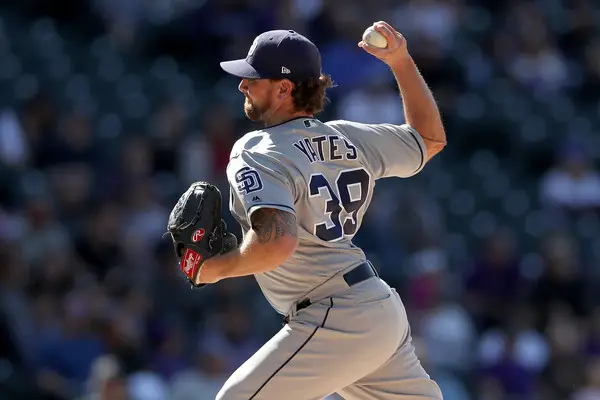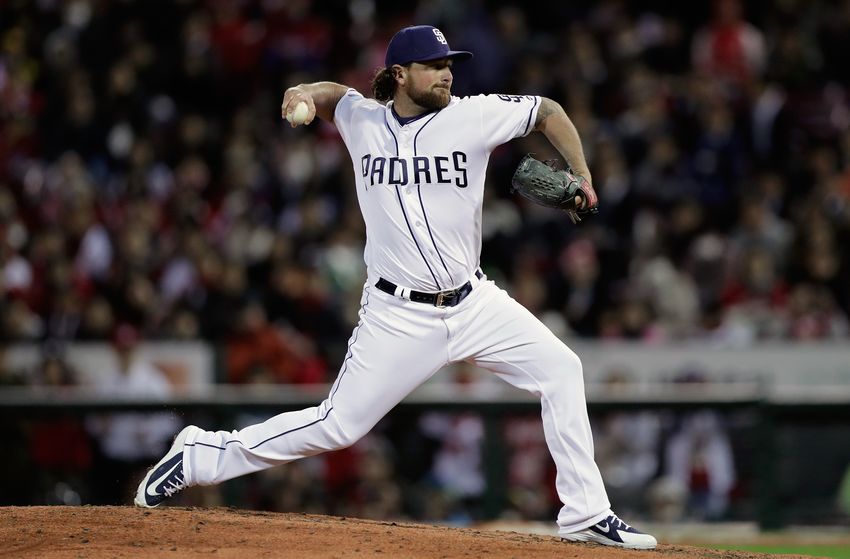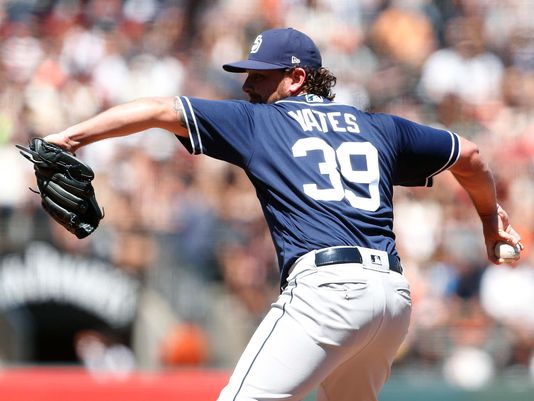San Diego Padres PNO (Positive/Negative/Outlook): Kirby Yates

Credit: AP Photo

Kirby Yates emerged in 2018 as a viable closing option for the San Diego Padres. Here is a look at his season and some positives and negatives to it. You will also get an outlook on Yates and what he holds for the future.
Many players underproduced for the San Diego Padres in 2018, including much of the offense and three-fifths of the starting rotation. Despite another losing season from the Padres, one aspect they could boast about was their bullpen, which finished sixth in MLB with a collective 3.53 ERA.
San Diego had many talented relievers who slotted into the pen, including flamethrowers Trey Wingenter and Robert Stock, as well as the rehabbing but effective Matt Strahm. However, none of those pitchers were as effective as Kirby Yates, who looked like an entirely different pitcher in 2018.
Yates was the reason why manager Andy Green wasn’t worried after MLB All-Star closer Brad Hand was traded to the Cleveland Indians, as the 31-year-old reliever comfortably slid into the closer spot.
Yates transformation from the waiver-wire to ace reliever was one of few bright spots for the Padres. Here are some positives, as well as negatives, on his season:
Positives
Higher Ground Ball Rate, Lower Fly Ball Rate
Prior to 2018, Yates was a notorious fly-ball pitcher when he was with the Tampa Bay Rays and Los Angeles Angels, and he struggled to generate ground balls. It showed last season as his 28.9% groundball rate was his lowest since his time with the Rays, while his 56.2% fly ball rate was the second-highest in the majors.
All of this changed in 2018, where Yates saw his ground ball rate spike to 42.8% while his flyball rate fell to 37.2%. This can be attributed to his brand-new splitter, which he began tinkering with during his time with the Angels, but it didn’t come to fruition until his acquisition by the Padres, where Darren Balsley encouraged him to apply it more often in games.
Said splitter was the reason Yates was so effective in the bullpen, as it served as a compliment to his potent four-seam fastball. Yates has gone from someone who can’t keep the ball out of the air to an efficient worm-burner inducer.
Strikeout Rate
Leading the charge for strikeouts was Yates, whose 90 strikeouts led the bullpen, and contributed to the 720 strikeouts by Padres relievers. Those 720 strikeouts were more than the 679 strikeouts by the starters, a testament to either the strength of the bullpen or the weakness of the starting rotation.
Again, Yates’ impressive repertoire is the reason as to why he was the bullpen’s strikeout king, with a 12.86 strikeout rate and a 29.2 K-BB% in his renaissance season. His K-BB% was good for sixth in the Majors amongst qualified relievers, better than elite relievers such as Craig Kimbrel, Adam Ottavino, Kenley Jansen, and Hand.

An increase in strikeouts didn’t equal an increase in walks. As a matter of fact, it was the opposite. His BB/9 and BB% rates sat at 2.43 and 6.8% at the end of the season, which were career bests. The increase in control, as well as stable strikeout rates, are needed if Yates is going to be the closer in the 2019 season.
Negatives
Age/Durability
When the calendar hits March 25th, Yates will be turning 32. Many in the baseball world consider the early ’30s to be the time when players start to drop off, but that is not always the case. For example, Craig Stammen notched a 2.73 ERA, 2.19 FIP and a 2.97 xFIP in his age-34 season, which was an improvement over his strong 2017 season, showing that Father Time can be deceived by some.
The more concerning question is; can Yates keep it up? He appeared in 65 games and pitched 63 innings in 2018, his most since his 2013 season with the Rays’ Triple-A facility when he appeared in 51 games and pitched 61.2 innings. As the closer, Yates is going to have logged a similar amount of innings, if not more.
Comparing him to his former battery mate Hand, the now-Indian appeared in 69 games and pitched 72 innings as a 28-year-old, sometimes pitching multiple innings (to the chagrin of some Padres’ fans) to earn a save. Yates will most likely be working under these same conditions, but he has to prove that he is durable enough to last the entire season as the closer.
Pedestrian second half
This may be a nitpick, but Yates’ numbers jumped after the All-Star break, especially in the month of August. Before the All-Star break, Yates carried a 1.43 ERA while opposing batters hit .167 off of him. He only allowed one home run while surrendering six runs total.
Post All-Star break? Yates allowed five home runs and nine total runs while posting a 3.20 ERA. While opponents only hit .202 off of him and he only blew one save, some may be concerned by the ERA jump during the second half of the season.
Is this a sign that Yates will break down as the closer? Or just looking in too deep? For what he has shown during his stint with the Padres, it is most likely the latter.
Outlook
2018 was the year that Kirby Yates went from a man tossed to the wayside to an ace reliever, proving to be another fine addition to AJ Preller’s long list of diamond-in-the-rough findings on the waiver wire. Yates continued to pile up strikeouts while shedding the “fly-ball pitcher” mantra off of himself. His season was so good, there was the talk of him being named to the All-Star Game instead of Hand.
Amidst all the All-Star talk and trade rumors (which will persist in 2019), Yates kept his head down and earned his keep in the Padres’ bullpen, and then some. 2019 will see the veteran hurler be looked upon to finish games while continuing to produce at the elite rate that he had last year.
I am currently attending San Diego State University while working on achieving a major in journalism. At SDSU, I write for The Daily Aztec while also hosting the sports radio show “Picked Off”, for KCR Radio. A loyal fan of San Diego sports, I hope to bring content that you will enjoy reading.